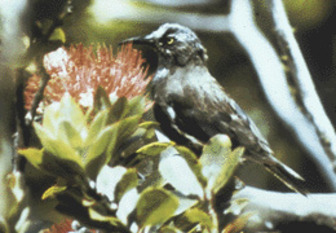Kauai Oo
This bird was among the smallest of the Hawaiian honeyeaters, if not the smallest species, at just over 20 centimetres in length. It was black or very dark shiny brown with sparse yellow leg feathers and faint white banding on the breast and underwings. It was named the ʻōʻō ʻāʻā by the natives which means dwarf ʻōʻō. Like other honeyeaters it had a sharp, slightly curved bill for sampling nectar. Its favored nectar sources were Lobelia species and the ʻohiʻa lehua tree, and it also ate small invertebrates and fruit.

The Kauai Oo is classified as Extinct (EX), there is no reasonable doubt that the last individual has died.
Kauai Oo (Moho braccatus), The Birds of North America Online (A. Poole, Ed.). Ithaca: Cornell Lab of Ornithology; Retrieved from the Birds of North America Online: http://bna.birds.cornell.edu/bna/species/535a doi:10.2173/bna. More
On the final cut of the CD, a male Kauai oo sends out a series of mating calls, and then waits for a response. He never hears one. Once you know what the sounds are, and what's behind it, says Fitzpatrick, "you realize how much birds communicate to us about the importance of protecting the last remnants of the great wild landscapes of the Earth." "The sounds are spectacularly diverse, and in many cases very bizarre. But they are so rich with information. More
Family : Meliphagidae
Genus : Moho
Species : braccatus
Authority : (Cassin, 1855)
